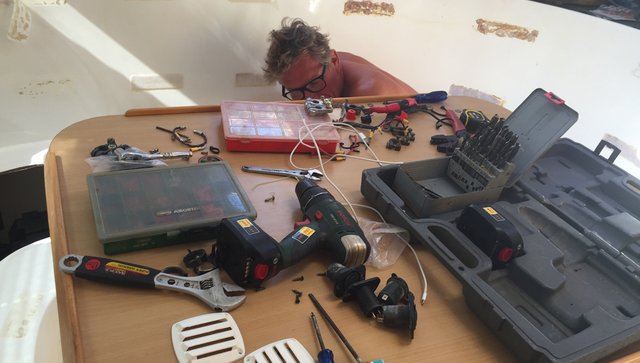Batteries for Ice
Batteries or Windlass?
We knew our anchor windlass was poorly. It was starting to slip and was clogging. By clogging I mean that the chain was getting caught above the hole that it fed into to go into the anchor locker. So when pulling up the chain it would clog and I would have to let a bit out again and slowly let it in again … before it clogged again.

The windlass is controlled by two foot switches, it is quite a knack to get it to go slowly. It seemed the motor was working fine but the was something that was lose that was sliding across the access hole the we were pulling the anchor up. Paul had already tightened the fixing bolts down and was surprised to find them all very loose indeed. The act of tightening up the bolts actually finished then off and within a couple of days of anchor action, the clogging was worse than ever.

A serious investigation was called for and Paul went in with his tools. He came back with bad news. “Looks like it’s a new windlass rather than the batteries”. Oh this wasn’t good! How were we going to manage with our current batteries with the imminent arrival of Sophie!
“We won’t get to pick up Sophie if we don’t have a new windlass” Paul explained. The though of picking up Sophie without new batteries was a little scary. Let me explain.
For a while our freezer had been at best a beer fridge. That is good enough to produce ice cold water and wine, not good enough to produce ice for Gin and Tonic! I will try to explain why.
We have 5 batteries on board. 4 house batteries and 1 starter battery. Our total output for the house was 400 watts. Please bear in mind that I am a girl and I am ok with maths but useless with physics, so even the thought of watts and amps turn my brain to mush. Paul has explained this a million times to me but I obviously am blocking it from going into my Brian or being stored there. I expect Paul will correct this before you read it, but if not I will apologise in advance if I get this completely upside down and the wrong way round.
We had calculated (because I like doing the maths) that we required 1100 watts of power in a 24 hour period. This was taking into consideration a one third duty cycle for the fridge and the freezer. (so on the assumption that these devises are pulling power for 8 hours out of 24). We divided 1100 watts by 12 to get 91.6 amps (rounded up to 100amps) in a 24 hour period. We calculated using 12 hours of daylight and 12 hours of no solar charge, we also read that we should only be using 10% of the battery capacity therefore we would require a battery bank of at least 500 amp per hours to give us the 50amps required each night when the solar wasn’t working.
So we currently have 400 A\h with the current batteries, and they were engine start batteries not deep cycle batteries. We had already replaced one battery (with a dual purpose battery) which had starting getting very hot and we had just discovered another battery was seriously on its way out.
Paul’s explanation of a deep cycle battery as apposed to an engine start battery is this:
An engine start battery is like a sprinter … it can give a lot of charge over a small amount of time. A deep cycle battery is more like a long distance runner giving out less charge over a much longer period of time.
So I understand why we need the right sort of battery for the job, and I can understand why we were having difficulty getting the batteries to recharge fully despite us having double the solar panels and sunshine than we ever had in the UK. Maybe I will get to grips with the physics of batteries after all. Homeschooling is the way to go ….especially if you live on a boat!
At night we were turning off the freezer, we had the anchor light on and a fan running, but still we were draining the batteries down much further than we should have been. We were struggling to keep the fridge and freezer cold, in fact, we had started using the freezer as a beer fridge, which kept the water and wine icy cold but didn’t actually freeze anything.
So here we are with 4 batteries being over extended every night and still providing not enough power to get us through. We had had to run the generator every morning for the last two weeks to get the batteries back up to 12 volts in the morning. And still no ice in the freezer.
Now my concern was that even if we replaced the batteries (at vast expense) was it the fridge and freezer that needed replacing as they were taking soooo much power, or, even worse, our 7 solar panels, were they producing the power they should be. What if we replaced the batteries and then realised that it was the other equipment that was the problem and we still would have no ice!
Decisions, decisions!
Such a dilemma! But then another battery over heated … we were down to 3 batteries so something needed to be done, and quickly! We now didn’t have much choice. We had to have a new anchor windlass and we had to have new batteries and we could just hope and pray that we didn’t need new fridge or /and freezer or solar panels at the same time.
So decisions made … we needed to find new affordable batteries that fitted into the space we had but provided us with the extra power that we needed to run the fridge and freezer and we needed a new anchor windlass as well.
Sounds very much like a first-world problem if you ask me :-)
It's not that hard to trouble-shoot. I bought some devices from China that can be connected to the power supply i.e. to the fridge to count the watt-seconds or kilowatt-hours it consumes - I suppose it should be possible to find some similar counters locally. If not, you should have a multimeter on board (and if you don't - buy one or two!), allowing you to see how many amperes the fridge is consuming (and multiply with the battery voltage to find the watts). It's a bit difficult with the fridge since it's running duty-cycles, and the energy consumption is dependent on how much it's on versus how much it's off. To get an approximation, you can set up a timer and measure the electricity consumption i.e. every whole hour, and take the average of the numbers.
Checking the solar panels is also quite so easy - just use the multimeter to see how many amperes it's delivering. Often the charge controller also has a display (sometimes the display has to be purchased separately) showing the stats.
Check that the power drawn from the battery bank matches up with the power drawn from the fridge when you believe there is nothing else drawing electricity. Perhaps there is something else eating your energy.
Also, you should find out if your battery bank is fully charged or not when the sun goes down (and run the generator for a while in the evening if it isn't).
Fridges and freezers do consume quite some energy, but this sounds excessive. There are special boat models that are supposed to spend much less energy than the regular units meant for installation in houses.
There are three reasons for a fridge to spend "too much" power;
Another trick is to run the fridge on full power (i.e. put the thermostat low) whenever the solar panels or generator is delivering plenty of energy, and lower power (put the thermostat high) when it's needed to save the batteries. Use those freezing boards to keep a stable temperature.
Wow, I believe someone, is an electrical engineer, a really good electrician, or really like to tinker with stuff.
@marygreensmith I can say that you have recieved some really sound advise from @tobixen, and I agree. Check everything, but it sounds like the frig is a problem, a buddy Capt. Jo said it should not be near that high, he's an electrician as well.
Something else to think about, are you using a laptop? They are typically 60-90watts, at 60 watts that's +-5amps, at 12 hours is 60Ah, and maybe more with wireless, and watching videos etc. That and possibly lighting if everything isn't LED.
Hi tobixen,
Visit curiesteem.com or join the Curie Discord community to learn more.
Superb advice!
Physics is basically applied math, so it shouldn't be that hard. :-)
I often think of the units like unknown variables and pull them with me in the equations. If I get the incorrect units in the answer, I know I've done something wrong. Units can to some extent be converted - one Watt is the same as one Ampere multiplied with one Volt. One Joule is the same as one Watt multiplied with one second.
Things tend to get complicated as the battery capacity is often measured in Ampere-hours (Ampere multiplied with hours!) rather than Joule. To get the actual energy storage in the battery, it's needed to multiply it with the battery voltage (perhaps 12.3V is a good number). The result will be some number multiplied with Ampere multiplied with Volt multiplied with Hours. One Watt is one Ampere Volt, so you have the answer in Watt-Hours. If you want it in Joules, just multiply it with 3600 seconds / hour (that's equivalent to multiplying it with one!). Watt multiplied with Hours multiplied with seconds multiplied with hours divided by hours ... that collapses into Watt Seconds, which is the same as Joule!
Kilo Watt Hour is also a unit often used for energy. Remember that one kilo is basically just 1000 ...
(This may look complicated in writing - but try doing the maths with a pen and a paper! It's easy!)
Ordinary batteries can be charged down to 50% of the printed capacity, even more if it's for short periods. The batteries deteriorate faster if drawing the charge more - for old batteries that are already quite worn out and should be replaced relatively soon it should be OK to use even more of the capacity.
Welcome to the world of boating, by the way - things tend to break down faster than they can be repaired. Sailing is the most expensive way to travel for free. We do need to replace the sails, new sails will most likely cost something around 8000 EUR ... :-(
One more thing you can do, if you're going somewhere and know you'll be returning to the same spot: connect the anchor rode to a fender (make sure it can withstand the weight of the chain - use some rope if necessary) and just leave the anchor where it's sitting. My battery bank is also overdue for replacement, and the solar panels seems to be delivering very little power. And my main anchor winch is also having problems pulling up the anchor by now - despite that I've screwed up everything and applied oil/grease everywhere.